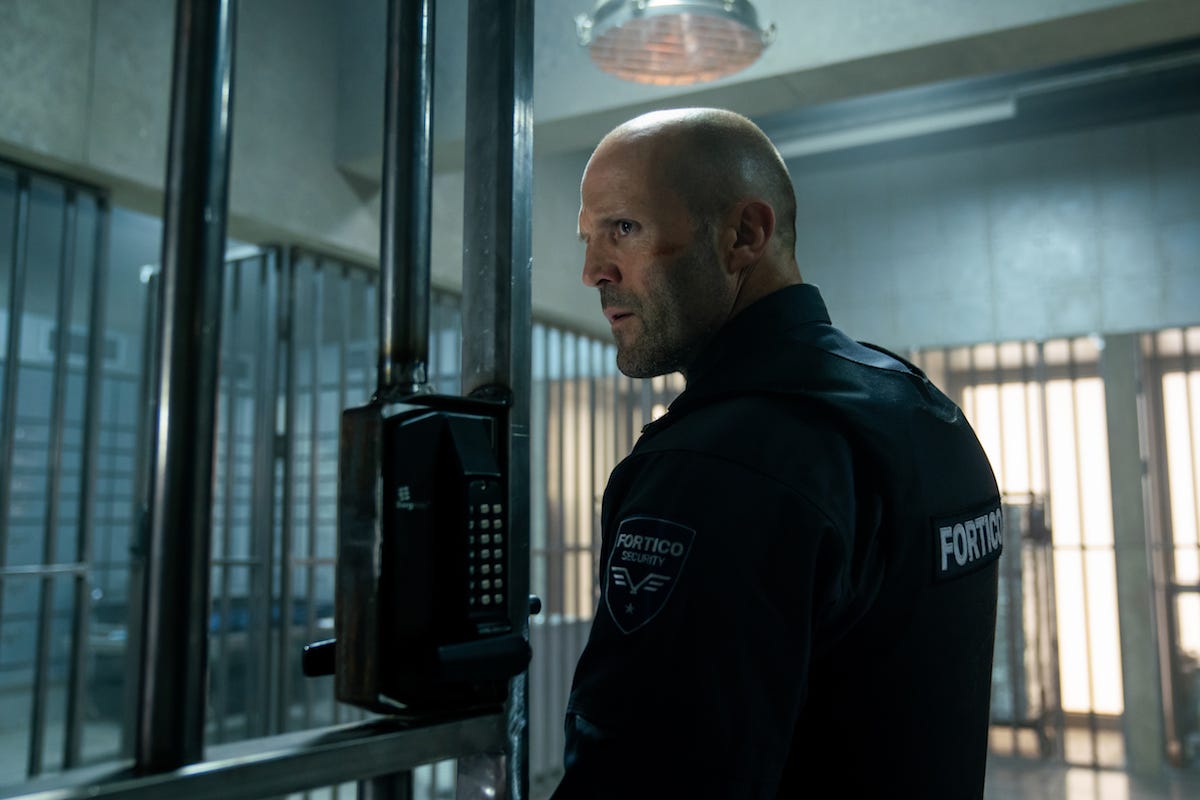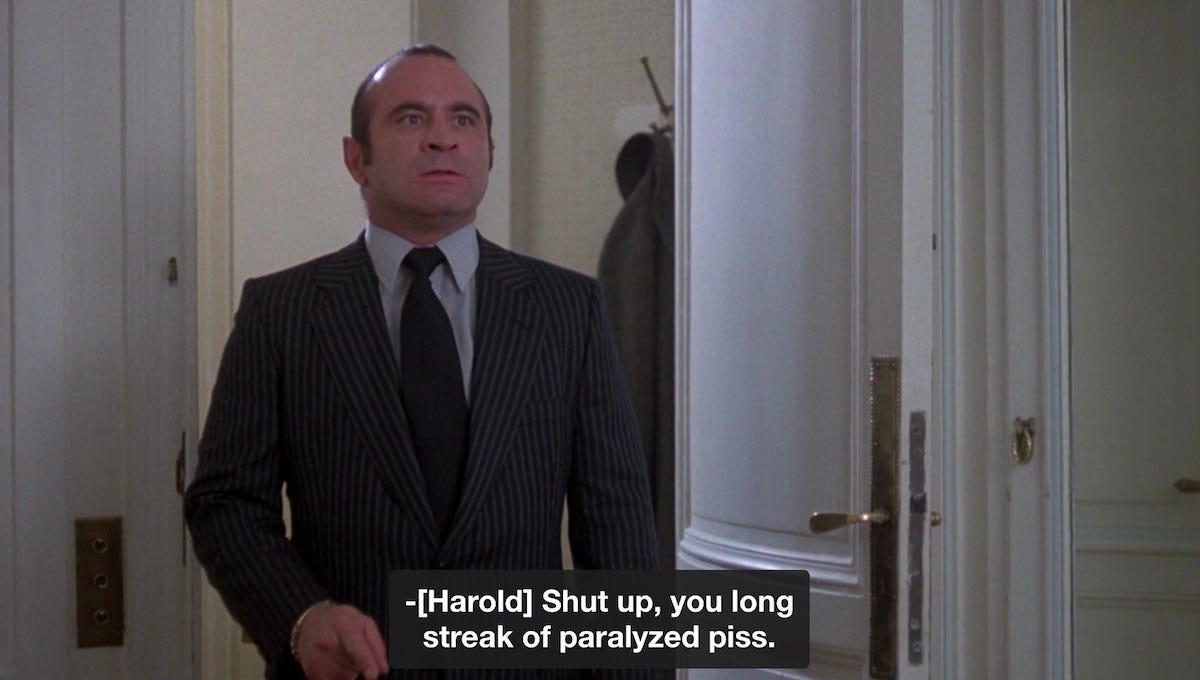‘Wrath of Man’ Review
Plus: what are YOU looking for from theaters as we return to them?
The new Guy Ritchie/Jason Statham movie doesn’t really feel much like the old Guy Ritchie/Jason Statham movies. This is not Snatch or Lock, Stock, and Two Smoking Barrels. It doesn’t feel much like The Gentlemen either, Ritchie’s 2019 return to the milieu of Brit-crime that made him famous.
Rather, Wrath of Man feels like a British crime movie from the 1970s or early 1980s, more akin to Get Carter or The Long Good Friday in its sense of quiet, dissolute brutality mixed in with an effort to keep the viewer in the dark. It also calls to mind The Counselor, Ridley Scott’s epic work of nihilistically mechanical cinema of cause and effect. Wrath of Man is stylish without being gaudy, brutal without being decadent in its application of violence. Yes, it’s a bit of a narrative mess, and sure, Ritchie blinks at the end rather than staring fully into the abyss. But it’s a delightfully nasty, mean-spirited piece of work that is sure to split audiences expecting something a bit more traditionally Ritchie-esque.
From this point on, I will be writing about some plot points in the film. If you’re interested in seeing the picture, you may want to revisit this review after. Consider yourself warned for spoilers.
Wrath of Man opens with a oner that doubles as the inciting incident. From the perspective of, basically, the backseat of an armored car, we watch from the inside as a heist goes down. The point of view intentionally obscures the action for us: we can see a bit outside of the truck through the front windshield; we can see a bit out the side after the robbers cut through the side, pull the guards out, and start unloading bags of cash. But we don’t know why the guards are executed and it’s unclear who the additional casualties are as the action progresses, with bits of dialogue hidden by Ritchie to heighten the suspense.
So when we shift from that opening vignette to the hiring, training, and deployment of new armored-car guard H (Jason Statham), we know that this mysterious man who proves his mettle in a gunfight during his first days on the job has something to do with that foundational slaughter. What, exactly, we don’t know. But there’s a reason this fearless, expert killer is shuttling bags of cash back and forth, and his coworkers Bullet (Holt McCallany) and Boy Sweat Dave (Josh Hartnett) are right to question why and how this gunslinger has wandered into their path.
The reason is revealed, and fairly quickly, which leads me to one of the two big issues I have with Wrath of Man: the shifting perspective of the script. Rather than letting the action unfold and clueing us in as we go, Ritchie is constantly putting us in the shoes of other characters, flashing back and flashing forward and changing whose POV we see the action from. First we flash back to H’s life as a mob boss, showing us why he’s so invested in finding out who committed the robbery that opens the movie. Then we shift to the POV of the crooks: veterans who commit armed robberies in order to recapture the thrill of martial life (and make a little extra dough in the process).
This would feel like more of a cheat if Ritchie weren’t so relentlessly brutal in his depiction of H’s life as a feared criminal; while he tries to track down the men responsible for sending him down this path, the violence employed is purposeful and merciless, occasionally difficult to watch. (Plastic bags have rarely been more terrifying.) There is blood and gore and it is occasionally extravagant but it is never cartoonish.
Wrath of Man loses a bit of steam when the POV shifts from H to the aforementioned vets; led by Jackson (Jeffrey Donovan) and plagued by hothead Jan (Scott Eastwood), the team is taking down scores at least as much because the action is the juice as the juice itself. Obvious forebears here are Den of Thieves and Heat, but those films do a better job of intercutting the cops-vs.-robbers idea. And besides: They’re all robbers here.
Which leads me to my final nitpick. The film builds to the sort of bodies-hitting-the-floor finale that hints at the inevitable finale of this type of life, a tightening noose that can only result in one outcome. Unfortunately, Ritchie and Statham try to have their cake and eat it too. There’s a way to have committed to that outcome—to have had one man’s wrath and vengefulness culminate in his own destruction while also securing said vengeance—but they chose not to. Pity.
Still, Wrath of Man is compelling and stylish, though not in the manic way Ritchie sometimes prefers. It’s more subdued, less enamored of rapid cuts or hip-hop montages or showy tricks with film stock. Staid isn’t the right word, exactly, but there’s a slower, more calculated feel to the pace and to the framing. All of this is accentuated by the film’s score, a somber, propulsive, strings-heavy composition from Christopher Benstead that calls to mind The Irishman, another movie about the consequences of our actions and the ways in which what we do can haunt us right up to the moment we die.
If Wrath of Man sounds like your jam, but your friends and loved ones aren’t quite sure whether or not they want to go, share this newsletter with them! Surely my mixed-positive review highlighting the wanton brutality of the film will convince them. And if you want to participate in the comments section below, make sure to become a paying member to Bulwark+.
What are YOU looking for from theaters?
Wrath of Man is only available to watch in theaters, a reversion to normal that’s going to be more common the further into vaccination penetration that we get. As it happens, this week I took part in an off-the-record chat with a bunch of exhibitors who wanted to get a sense of the industry and what people were looking for when they went to the movies.
I told them that whenever I write about theaters, I get three responses.
The first is that it’s not safe, I’m going to die of COVID, why would I go to theaters?
The second is that there’s no point, there’s nothing new to watch, why would I go to theaters?
The third is that going to theaters is less pleasant than watching at home, I like to be able to pause and pee, and besides I spent a ton on this new TV and I want to take advantage of it, so why would I go to theaters?
The first response is a.) wrong, and b.) will fix itself as vaccination rates increase.
The second response is a.) understandable, but b.) a problem that will fix itself as more studios roll out more product as people get more comfortable going back to theaters.
The third response is the trickiest one to answer. Because it’s true: TVs are bigger and better than ever; it’s nice being able to pause and go to the bathroom or get a drink or grab a snack; and you save a few bucks by not having to get a sitter.
So the big question is what can theaters offer people besides exclusive content like new, big budget movies? And I think part of the answer lies in things they’d already been doing before the pandemic, like offering better food options, craft cocktails, a superior lineup of beers on tap, etc. And another part of the answer lies in how they’ve responded to the pandemic: I think private screenings should be here to stay (possibly limited to the third weekend and beyond) because there’s something deeply enjoyable about splitting an entire theater with a couple of couples and making a night of it.
But what other changes could be made? Should theaters adopt Alamo Drafthouse-style fatwas against cell phone usage? Or go the other way: offer screenings to people who want to use their cell phones while watching? What additions can be made to the viewing experience to entice you, the movie lover reading this newsletter, back into theaters?
Comments are open for paying B+ members. I’d love to hear what you think should be done. (And, to be clear, this is not #SponCon; I’m not doing this at the behest of the National Association of Theater Owners, which organized the chat this week, or for their benefit. I’m mostly just curious to see what you all think.)
Assigned Viewing: The Long Good Friday (The Criterion Channel)
The Long Good Friday came to mind while watching Wrath of Man for a handful of reasons—the judicious application of relatively brutal violence; the accents—but the biggest was a key difference between the two. By tightly focusing on Harold (Bob Hoskins) and his bewilderment as to why his London crime operations are being torched, the viewer’s mystery is Harold’s own. We want to know who is roughing him up and why, and that desire implicates us somewhat in the action onscreen. Also: Hoskins’s command performance is yet another good reason to pick up the Criterion Channel if you’ve yet to do so.






Here is what theaters can do: Change the projection bulbs on schedule so the picture is as bright as it's supposed to be. And MASK THE SCREENS CORRECTLY.
"Or go the other way: offer screenings to people who want to use their cell phones while watching?"
They should definitely do this, but only so that we have at least a few soft targets that we don't need to defend and openly hope are hit.